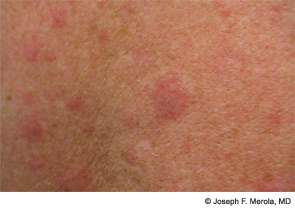
Figure 1: Diffuse erythematous, edematous tender plaques with a “pseudovesicular” appearance scattered over the upper back and chest with few scattered extremity lesions.
The Case
A 66-year-old woman with a history of antineutrophil cytoplasmic antibody (ANCA)–associated vasculitis presents with two days of fever and rash. The patient’s vasculitis was initially treated with a six-month course of intravenous cyclophosphamide and oral corticosteroids, and the patient was recently transitioned to oral azathioprine as maintenance therapy. A review of systems was also notable for arthralgias. She was febrile to 103ºF, and her physical exam revealed skin lesions scattered across her upper back, shown in Figure 1. The remainder of the patient’s physical exam was unremarkable.
What is your diagnosis?
- Bacterial sepsis
- Sweet’s syndrome
- Urticaria
- Systemic mycosis/deep fungal infection
- Recurrent ANCA-vasculitis with cutaneous involvements


